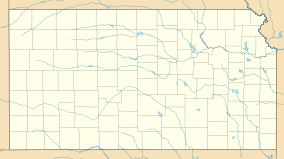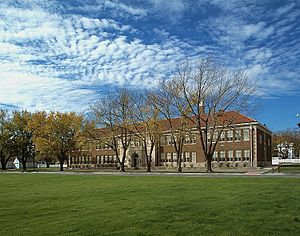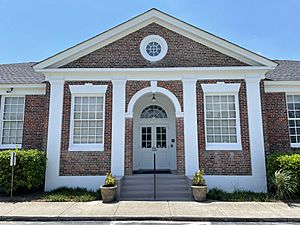Brown v. Board of Education National Historical Park facts for kids
Quick facts for kids Brown v. Board of Education National Historical Park |
|
|---|---|
| Location | Topeka, Kansas, and Summerton, South Carolina, United States |
| Nearest city | Topeka, Kansas |
| Area | 1.85 acres (0.75 ha) |
| Established | October 26, 1992 |
| Visitors | 16,886 (in 2011) |
| Governing body | National Park Service |
| Website | https://www.nps.gov/brvb/ |
|
Brown v. Board of Education National Historic Site
|
|
| Location | 1515 SE Monroe St, Topeka, Kansas |
| NRHP reference No. | 01000156 |
| Added to NRHP | October 26, 1992 |
The Brown v. Board of Education National Historical Park is a special place in Topeka, Kansas. It was created on October 26, 1992, by the United States Congress. This park helps us remember a very important decision made by the U.S. Supreme Court. This decision, called Brown v. Board of Education, helped end racial segregation in public schools.
On May 17, 1954, the Supreme Court said that having "separate schools for different races was not fair." They ruled that this went against the Fourteenth Amendment to the United States Constitution. This amendment promises "equal protection of the laws" for all citizens.
The park includes Monroe Elementary School. This was one of four separate schools for African American children in Topeka. The park was first known as a National Historic Site. It became a National Historical Park on May 13, 2022, and was also expanded. The park will also include Summerton High School and Scott’s Branch High School in Summerton, South Carolina. These schools will be added once the land is officially bought.
The Brown v. Board of Education case actually combined five different lawsuits. All these cases were about school segregation. They included cases from South Carolina, Virginia, Delaware, and Washington, D.C. By including these other schools, the park tells a bigger story. It shows the history of unfair education and the legal fight against it.
Contents
History of Monroe Elementary School
The story of Monroe Elementary School started long before the famous Brown court case. In 1855, John Ritchie, who was against slavery, bought land in Topeka, Kansas. After the American Civil War, many newly freed African Americans moved to Topeka. They built their homes on Ritchie's land.
Because many African American families lived there, the school board decided to build a school for Black children. This school was built on Ritchie's land and became Monroe School. After Ritchie passed away in 1887, the Topeka Board of Education bought the land. They wanted to build a new school for African American children.
The building you see today is actually the third Monroe school on that corner. The first school was in a small rented building from 1868. A permanent building was put up in 1874. The current school building was finished in 1926. It was designed by Thomas W. Williamson, a well-known Topeka architect. His company designed many modern schools for Topeka between 1920 and 1935.
Monroe Elementary School is a two-story building made of brick and limestone. It was built in the Italian Renaissance Revival style. The school was made with excellent materials and the best technology of its time.
In 2004, a teacher from Monroe, Barbara Ross, shared her memories. She said:
I feel they were good schools. They had qualified black teachers ... very qualified. Many people ... well, I'll say some people ... felt that the supplies and things that were furnished in the buildings were not comparable with those in the white schools only because they were probably older buildings. They had the same books and we've heard a lot of things about that. But they had the same books that the others had because so many of the black teachers were on the committees to select the books—the textbooks. So we know we had the same books that they did. It's true—everything wasn't just right because the things in the community weren't just right. We couldn't go eat any place. We couldn't go to the theater and sit any place. We couldn't live in an apartment or go to a motel; we had to stay with a black family when we came here to teach.
Monroe was the newest of the four schools for Topeka's African American community. The other schools were Buchanan, McKinley, and Washington. Washington School no longer exists. The Topeka Board of Education no longer owns the other two schools.
In the Brown case, the court did not say that Black schools in Kansas were worse in terms of buildings or books. Instead, the court said that separating children by race in schools was unfair. It harmed the education of Black children. The ruling that "separate" schools were unconstitutional by themselves made Brown a very important case.
The court's decision stated:
Does segregation of children in public schools solely on the basis of race, even though the physical facilities and other "tangible" factors may be equal, deprive the children of the minority group of equal educational opportunities? We believe that it does.
Saving Monroe School
Monroe School closed in 1975 because fewer students were attending. The school district used the building as a storage place. They also used the grounds for parking and fixing buses. Eventually, the school and its land were sold to private owners.
Monroe Elementary was privately owned for over fifteen years. Some owners wanted to turn it into offices or a private school. One owner, Mark A. Steuve, bought it in 1988 to use as a warehouse. In 1990, he planned to sell the building at an auction.
The Brown Foundation started a campaign to save Monroe Elementary School. They wrote many letters and met with local leaders. With help from the Trust for Public Land, the school was saved. The Trust for Public Land bought the property in 1991. On October 26, 1992, President George H. W. Bush signed a law. This law created the Brown v. Board of Education National Historic Site. The National Park Service took ownership in December 1993.
South Carolina Schools and the Fight for Equality
Summerton High School in South Carolina was a school only for white students. It did not allow Black students to attend. Black students had to go to Scott's Branch High School. This school was built in 1951. It was supposed to offer a similar education for African American students.
However, the differences between these schools were challenged. This challenge happened in the Briggs v. Elliott court case. This case was one of the five combined into the Brown v. Board decision.
Other Important Schools in the Movement
The National Park Service has also recognized five other schools. These schools are called "affiliated areas." This means the National Park Service helps share their history. They provide money and advice, but they do not own these sites.
These important schools include:
- Robert Russa Moton School in Farmville, Virginia
- Howard High School in Wilmington, Delaware
- Claymont High School in Claymont, Delaware
- Hockessin Colored School #107 in Hockessin, Delaware
- John Philip Sousa Junior High School in Washington, D.C.







